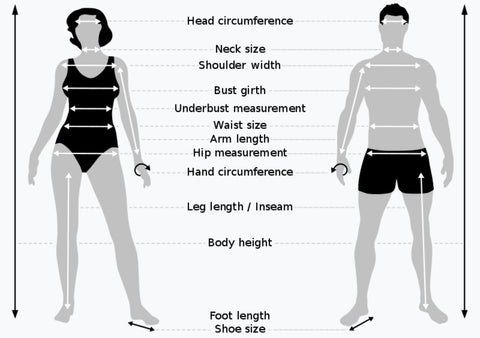How to Correctly Measure for Men's Clothing Sizes
It’s tough to buy clothes online, because you can’t try them on to make sure you’ve got the right size! Fortunately, taking some simple body measurements can go a long way to solving the problem. Simply follow this handy guide to learn how to measure your body like a tailor, and then compare your body measurements to your favorite brand’s size chart to find your size. (Note that we have a separate measuring guide for shoes!)
What You’ll Need
To get your measurements, you’ll probably need some tailor’s measuring tape. Simple tailor’s tape can be purchased cheaply on Amazon. Also grab a spouse, parent, or friend, because getting good body measurements will be a lot easier with an extra pair of hands.
If you don’t have any tailor’s tape and you’d like to get started right away, a workaround is to grab a piece of string, a marker, and a ruler. Wrap the string around the body part you want to measure, mark it with the marker, and then use the ruler to measure from the end of the string to the mark you made. In a pinch, you can even substitute a piece of holiday ribbon in place of string. (But honestly, you’re better off just buying some tailor’s tape so your measurements are precise and you’re always ready to shop online again!)
General Tips
Pull the tape tight enough around a body part that it stays straight and level, but not so tight that it compresses the skin. For maximum accuracy, you’re looking for a happy medium between tight and loose.
Measure on bare skin rather than over clothing.
Make sure you use the right units. Some of our brands' size charts use inches, while others use centimeters; don't confuse the two! To convert centimeters to inches, divide by 2.54.
Measure on bare skin rather than over clothing.
Make sure you use the right units. Some of our brands' size charts use inches, while others use centimeters; don't confuse the two! To convert centimeters to inches, divide by 2.54.
How to Measure for Men’s Clothing
For men’s clothing, the most common measurements are neck, shoulder, sleeve length, center back sleeve length, chest, waist, seat or hip, and inseam. We’ll take each in turn.
Neck
To measure a man’s neck, place the tape just below the Adam’s apple, where the neck joins the shoulder muscles. For a comfortable fit, place a finger between the tape and neck to ensure the tape isn’t too snug.
Shoulder
To measure a man’s shoulders, stand behind him and place the end of the tape at the tip of his shoulder, where the horizontal slope of the shoulder joins the vertical slope of the arm. To find the right spot, trace a line straight upward from the armpit to the top of the shoulder. (If he isn’t too muscular, feel for the bone to make sure you’ve found the spot.) Then strech the tape across his back to the same point on the opposite shoulder, following the natural curve of the back.
Sleeve Length
Annoyingly, men's sleeve lengths are measured a couple different ways, so pay attention to which type of sleeve measurement you're looking for. For regular sleeve length measurements, start from the tip of the shoulder—the same spot you used for the shoulder measurement—and run the tape down the outside of the arm to the wrist bone. Bend the arm slightly for this measurement. The tape should follow the bend of the arm. This type of sleeve length measurement is most commonly used for jackets.
Center Back Sleeve Length
For center back sleeve measurement, have him hold his arm out straight to the side, horizontally away from his body. Measure from the center of his upper back—at the bottom of the neck—to his shoulder, and then all the way down his arm to the wrist bone. This type of sleeve length measurement is most commonly used for men's shirts.
Chest
To measure a man’s chest, wrap the tape beneath his armpits, fully encircling his body around the widest portion of his chest. He should relax and let his arms hang straight at his sides. This measurement is best taken from the front.
Waist
Measure the waist where you want the waistline of your pants to sit. Traditionally men’s waists are measured at the natural waistline, just above the belly button. One way to find the natural waist is to bend the torso to the side and find the crease. This natural waist measurement is best for use with trousers or high-rise pants. However, most men’s casual pants and jeans today sit much lower than the natural waist, just above the hip. As with the chest, for this measurement you’ll want to encircle the waist with the tailor’s tape.
Seat or Hip
For a seat or hip measurement, wrap the tape around the widest part of the hip and buttock. This is another circumferential measurement, which means you’ll want to encircle the body with the tape.
Inseam
To measure a man’s inseam, run the tape along the inner leg from the lowest portion of the groin and genitals to the bottom of the ankle. He should stand up straight and should not bend the leg for this measurement. He likely will not be able to take this measurement without help.
That’s All There Is To It!
Congratulations! You’re done! Once you’ve jotted down all your accurate body measurements, compare them to the size chart for your favorite brand to find your clothing sizes. Then you’re ready to shop on Outdoor Equipped for men’s clothes!


